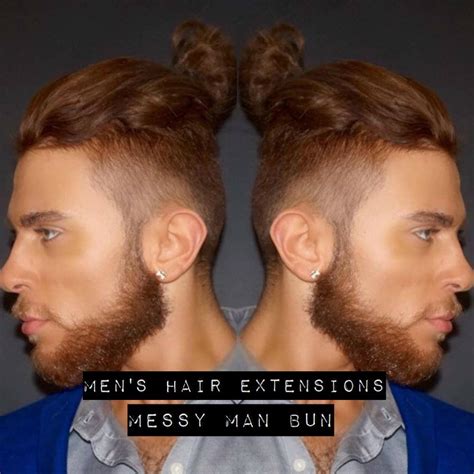Table of Contents
- Introduction to Men’s Hair Extensions
- Types of Men’s Hair Extensions
- How to Choose the Right Men’s Hair Extensions
- Styling and Maintenance of Men’s Hair Extensions
- Benefits and Drawbacks of Men’s Hair Extensions
- Tips and Tricks for Men’s Hair Extensions
In a world where hair loss and thinning hair is becoming increasingly common, men’s hair extensions have emerged as a revolutionary solution for those seeking to restore their confidence and revitalize their appearance. With an estimated 50% of men experiencing some form of hair loss by the age of 50, the demand for men’s hair extensions is expected to soar in the coming years.

This comprehensive guide delves into the world of men’s hair extensions, providing you with everything you need to know about choosing, styling, and maintaining your new hair system.
Types of Men’s Hair Extensions
Men’s hair extensions come in a wide range of types, each with its own unique set of features and benefits. The most common types include:
1. Clip-In Hair Extensions
Clip-in hair extensions are the most popular type of hair extensions for men. They are easy to apply and remove, making them a great option for those who want to change their hairstyle without a long-term commitment. Clip-in extensions are typically made of synthetic fibers, but high-quality human hair extensions are also available.
2. Tape-In Hair Extensions
Tape-in hair extensions are another popular option for men. They are applied using double-sided tape, which creates a strong bond between the natural hair and the extensions. Tape-in extensions are typically made of human hair, and they can last for up to 8 weeks with proper care.
3. Fusion Hair Extensions
Fusion hair extensions are the most permanent type of hair extensions. They are applied using heat, which melts the keratin in the hair and bonds the extensions to the natural hair. Fusion extensions are typically made of human hair, and they can last for up to 6 months with proper care.
Choosing the right men’s hair extensions can be a daunting task, but by following these simple steps, you can find the perfect solution for your needs:
1. Determine Your Hair Loss Pattern
The first step is to determine your hair loss pattern. This will help you choose the right type of hair extensions and the appropriate length and density. There are two main types of hair loss patterns in men:
- Androgenetic alopecia (male pattern baldness): This is the most common type of hair loss in men. It is characterized by a receding hairline and thinning hair on the top of the head.
- Alopecia areata: This is an autoimmune disorder that causes hair loss in small, round patches.
2. Choose the Right Type of Hair Extensions
Once you have determined your hair loss pattern, you can choose the right type of hair extensions. Clip-in hair extensions are a great option for those who want a temporary solution or who want to experiment with different hairstyles. Tape-in hair extensions are a more permanent option and are a good choice for those who want to add volume and length to their hair. Fusion hair extensions are the most permanent option and are the best choice for those who want to drastically change their appearance.
3. Select the Right Length and Density
The length and density of your hair extensions will depend on your personal preferences. If you want to add length and volume to your hair, you will need to choose extensions that are longer and denser than your natural hair. If you want to cover up thinning hair, you will need to choose extensions that are shorter and less dense.
Once you have chosen and applied your hair extensions, it is important to style and maintain them properly. Here are a few tips:
1. Styling
You can style your hair extensions just like your natural hair. You can use heat styling tools, such as blow dryers, curling irons, and flat irons, but be sure to use a heat protectant spray to prevent damage. You can also use hair products, such as shampoos, conditioners, and styling gels, to keep your extensions looking their best.
2. Maintenance
Hair extensions require regular maintenance to keep them looking their best. You should wash and condition your extensions every 3-4 days. You should also brush your extensions regularly to prevent tangles. You should have your extensions professionally maintained every 4-6 weeks to keep them in place and to prevent damage.
Benefits and Drawbacks of Men’s Hair Extensions
Benefits
- Can help to restore lost hair and volume
- Can improve self-confidence and appearance
- Can be used to create different hairstyles
- Can be a relatively affordable way to improve your hair
- Low-maintenance and easy to apply
Drawbacks
- Can be expensive
- Can be uncomfortable to wear
- Can damage natural hair if not applied and maintained properly
Here are a few tips and tricks to help you get the most out of your men’s hair extensions:
- Start with a small number of extensions to see how you like them before investing in a full set.
- Be sure to choose a reputable salon or stylist to apply your hair extensions.
- Follow the care instructions for your extensions to keep them looking their best.
- Be patient with your extensions. It may take some time to get used to having them in your hair.
Men’s hair extensions can be a great way to restore lost hair and improve your appearance. By following the tips and advice in this guide, you can choose, style, and maintain your hair extensions so that they look and feel natural.
Frequently Asked Questions
Q: How much do men’s hair extensions cost?
A: The cost of men’s hair extensions varies depending on the type of extensions, the length and density of the
